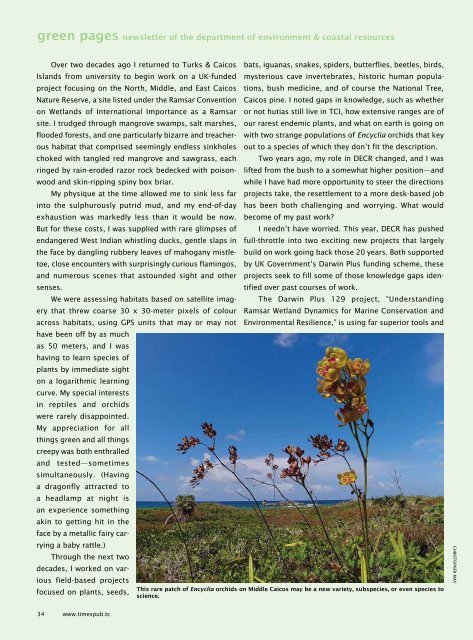Times of the Islands Winter 2022/23
Presents the "soul of the Turks & Caicos Islands" with in-depth features about local people, culture, history, environment, real estate, businesses, resorts, restaurants and activities.
Presents the "soul of the Turks & Caicos Islands" with in-depth features about local people, culture, history, environment, real estate, businesses, resorts, restaurants and activities.
- No tags were found...
Create successful ePaper yourself
Turn your PDF publications into a flip-book with our unique Google optimized e-Paper software.
green pages newsletter <strong>of</strong> <strong>the</strong> department <strong>of</strong> environment & coastal resources<br />
Over two decades ago I returned to Turks & Caicos<br />
<strong>Islands</strong> from university to begin work on a UK-funded<br />
project focusing on <strong>the</strong> North, Middle, and East Caicos<br />
Nature Reserve, a site listed under <strong>the</strong> Ramsar Convention<br />
on Wetlands <strong>of</strong> International Importance as a Ramsar<br />
site. I trudged through mangrove swamps, salt marshes,<br />
flooded forests, and one particularly bizarre and treacherous<br />
habitat that comprised seemingly endless sinkholes<br />
choked with tangled red mangrove and sawgrass, each<br />
ringed by rain-eroded razor rock bedecked with poisonwood<br />
and skin-ripping spiny box briar.<br />
My physique at <strong>the</strong> time allowed me to sink less far<br />
into <strong>the</strong> sulphurously putrid mud, and my end-<strong>of</strong>-day<br />
exhaustion was markedly less than it would be now.<br />
But for <strong>the</strong>se costs, I was supplied with rare glimpses <strong>of</strong><br />
endangered West Indian whistling ducks, gentle slaps in<br />
<strong>the</strong> face by dangling rubbery leaves <strong>of</strong> mahogany mistletoe,<br />
close encounters with surprisingly curious flamingos,<br />
and numerous scenes that astounded sight and o<strong>the</strong>r<br />
senses.<br />
We were assessing habitats based on satellite imagery<br />
that threw coarse 30 x 30-meter pixels <strong>of</strong> colour<br />
across habitats, using GPS units that may or may not<br />
have been <strong>of</strong>f by as much<br />
as 50 meters, and I was<br />
having to learn species <strong>of</strong><br />
plants by immediate sight<br />
on a logarithmic learning<br />
curve. My special interests<br />
in reptiles and orchids<br />
were rarely disappointed.<br />
My appreciation for all<br />
things green and all things<br />
creepy was both enthralled<br />
and tested—sometimes<br />
simultaneously. (Having<br />
a dragonfly attracted to<br />
a headlamp at night is<br />
an experience something<br />
akin to getting hit in <strong>the</strong><br />
face by a metallic fairy carrying<br />
a baby rattle.)<br />
Through <strong>the</strong> next two<br />
decades, I worked on various<br />
field-based projects<br />
focused on plants, seeds,<br />
bats, iguanas, snakes, spiders, butterflies, beetles, birds,<br />
mysterious cave invertebrates, historic human populations,<br />
bush medicine, and <strong>of</strong> course <strong>the</strong> National Tree,<br />
Caicos pine. I noted gaps in knowledge, such as whe<strong>the</strong>r<br />
or not hutias still live in TCI, how extensive ranges are <strong>of</strong><br />
our rarest endemic plants, and what on earth is going on<br />
with two strange populations <strong>of</strong> Encyclia orchids that key<br />
out to a species <strong>of</strong> which <strong>the</strong>y don’t fit <strong>the</strong> description.<br />
Two years ago, my role in DECR changed, and I was<br />
lifted from <strong>the</strong> bush to a somewhat higher position—and<br />
while I have had more opportunity to steer <strong>the</strong> directions<br />
projects take, <strong>the</strong> resettlement to a more desk-based job<br />
has been both challenging and worrying. What would<br />
become <strong>of</strong> my past work?<br />
I needn’t have worried. This year, DECR has pushed<br />
full-throttle into two exciting new projects that largely<br />
build on work going back those 20 years. Both supported<br />
by UK Government’s Darwin Plus funding scheme, <strong>the</strong>se<br />
projects seek to fill some <strong>of</strong> those knowledge gaps identified<br />
over past courses <strong>of</strong> work.<br />
The Darwin Plus 129 project, “Understanding<br />
Ramsar Wetland Dynamics for Marine Conservation and<br />
Environmental Resilience,” is using far superior tools and<br />
This rare patch <strong>of</strong> Encyclia orchids on Middle Caicos may be a new variety, subspecies, or even species to<br />
science.<br />
CHRISTOPHER MAY<br />
34 www.timespub.tc
















